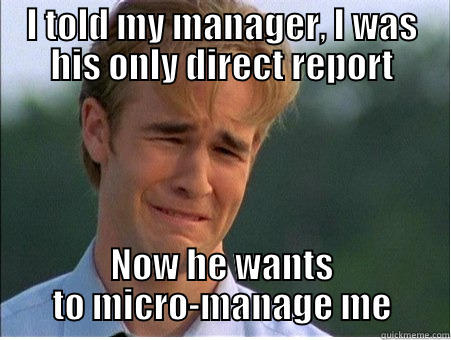 How many direct reports is the most effective for a leader? How many direct reports is the most effective for a leader? Structure your team for success with the right view of span of control, interactions and direct reports. When an organization grows beyond the one-person operator delivering goods and/or services out of their garage, the process of building systems for success becomes essential to long term health. What works as a small company has to evolve as the company grows or the organization will outgrow the preceding systems. As an organization grows, adapts, changes and evolves, one question every leader and organizational system must answer is how many direct reports any given person in a position of leadership should have. At the end of the day this question has no right answer given that each organization is unique and each manager has a different threshold for efficacy. Let’s take a look at some of the metrics, discussions and insights related to the topic of finding the right number of direct reports. Gauging interactions (energy output) How do you measure efficacy when assessing the right number of direct reports? Business Insider took a peek at the number of reports of Tim Cook, the COO made CEO of Apple, who was believed to have upwards of 17 direct reports. Hal Gregersen, Ph.D., the executive director of the MIT Leadership Center states, “It's a question of how many people a leader can have a constructive conversation with when everyone is in the same room (Lebowitz, 2015).” Time is a limited resource that every manager only has so much of and trust is the greatest asset in developing employee engagement in an organization, the question is not how thin can a leader stretch themselves but how effective they can be in leading the members of their team whether directly or indirectly. Business journals and many persons in a position of leadership (PIAPOL) site Japanese management philosophy and regard 6-7 direct reports as the maximum number that a leader can effectively manage. In his own defense, Tim Cook emailed a response to Business Insider countering that, “"If you have smart people, a strong organizational culture, and a well-defined and articulated strategy that everyone understands, you can [have] numerous direct reports because your job isn't to tell people what to do.” Whether those analyzing a leader from within the organization or from the outside agree with the direction and decisions that they make, at the end of the day they will rise or fall based upon how they approach their leadership responsibilities. Measuring span of control So much of this discussion on the optimum number of direct reports is opinion based, one metric cited by Schaffer Consulting remarks that span of control is something which can be measured in this discussion, “When a manager goes from four to five subordinates, his potential interactions with them increase from 44 to 100 over a given period; and going from seven to eight subordinates raises the total interactions from 490 to 1,080 (Inc.).” This is a classic business concept that continues to be of relevance and value to organizations such as the United States Air Force in their goal of focusing missional clarity. Size of the organization obviously comes into play and the overall structure of a team must be crafted to support it’s necessary functions as well as it’s growth goals. As for the ethereal question "What is the right span of control for a manager," a consultant Jamie Flinchbaugh blogged, "Some factors to consider are: The narrower the span of control, the more coaching at the point of activity can be done; the broader the span of control, the more the entire process can be encompassed within fewer decision makers and more aligned decisions (The Build Network, 2014).” This is a simplified means of looking at the bigger picture, but a leader must analyze the position they are in with regards to the development of their organizational structure to determine where their immediate efforts are most valuable. Does the leader need to be directly involved in the training of key share holders in the building process or do they need to take a few steps back from the process to empower those on their leadership team to take ownership for their areas of responsibility. Avoiding top heavy management If the number of direct reports is too low, because the team has built multiple layers of upper and middle management to insulate those in positions of executive leadership there is a potential for disconnect. When an organization becomes slow and top heavy by way of structure, there are too many layers to weave through in order to accomplish anything in a timely or mission centered manner. As far back as 1989, Jack Welch, the CEO credited with turning GE around, was an advocate against the six direct report rule for many of these reasons. In an interview with Harvard Business Review, the management guru shared his candid thoughts on the matter, “We took out management layers. Remember the theory that a manager should have no more than 6 or 7 direct reports? I say the right number is closer to 10 or 15. This way you have no choice but to let people flex their muscles, let them grow and mature. The leader can focus only on the big important issues, not on minutiae (Tichy & Charan, 1989).” Systems should be built to support the people in the field who are making the products and/or delivering the services that make up the core functions of the organizations value interaction with the market. The question of the right number of direct reports is not a matter of ego nor strictly of science, but rather is a key discussion that will evolve with the needs of the organization in a manner that is unique to that team. Mike Myatt, Forbes contributor and chairman of N2 Growth, shares, “Where many leaders become disoriented is by confusing platform with people, and position with responsibility. Here’s the thing – it’s not about the platform, it’s about the people. Without the people there is no platform, and ultimately nothing to lead. It’s not about you (the leader), but what you can create and influence through those you lead (Myatt, 2012).” Rather than looking for the perfect number of direct reports, a leader should ask how many people they can effectively support to keep the vision and mission of the organization moving forward with relationship to the team’s values. Clarity. Consistency. Accountability. References: Lebowitz, S. (July 8, 2015) Apple CEO Tim Cook now has 17 direct reports – and that’s probably too many. Business Insider. Retrieved from http://www.businessinsider.com/apple-ceo-tim-cook-has-too-many-direct-reports-2015-7 The Build Network (April 3, 2014) Wait, how many reports direct reports did you say you have? Inc. Magazine. Retrieved from https://www.inc.com/the-build-network/direct-report-challenges.html Tichy,N., Charan, R. (October 1989) Speed, simplicity, self-confidence: An interview with Jack Welch. Harvard Business Review. Retrieved from https://hbr.org/1989/09/speed-simplicity-self-confidence-an-interview-with-jack-welch Myatt, M. (November 5, 2012) Span of control – 5 things every leader should know. Forbes. Retrieved from https://www.forbes.com/sites/mikemyatt/2012/11/05/span-of-control-5-things-every-leader-should-know/#7f921b0328c8
0 Comments
Leave a Reply. |
AuthorThoughts on personal and professional development. Jon Isaacson, The Intentional Restorer, is a contractor, author, and host of The DYOJO Podcast. The goal of The DYOJO is to help growth-minded restoration professionals shorten their DANG learning curve for personal and professional development. You can watch The DYOJO Podcast on YouTube on Thursdays or listen on your favorite podcast platform.
Archives
March 2023
Categories
All
<script type="text/javascript" src="//downloads.mailchimp.com/js/signup-forms/popup/unique-methods/embed.js" data-dojo-config="usePlainJson: true, isDebug: false"></script><script type="text/javascript">window.dojoRequire(["mojo/signup-forms/Loader"], function(L) { L.start({"baseUrl":"mc.us5.list-manage.com","uuid":"b9016446bd3c6a9f0bd835d4e","lid":"83282ffb9e","uniqueMethods":true}) })</script>
|
Jon Isaacson |
Connect. Collaborate. Conquer.
© COPYRIGHT 2015. ALL RIGHTS RESERVED.
|



 RSS Feed
RSS Feed